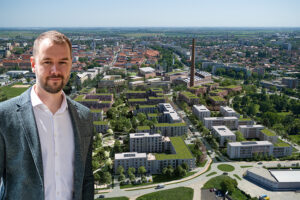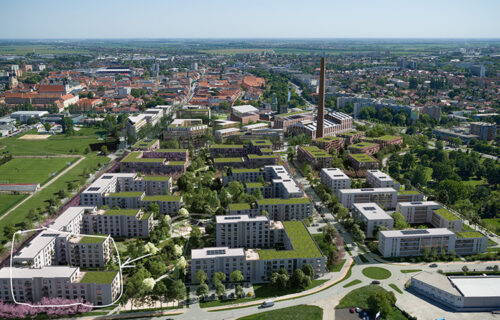
The Cukrovar project in Trnava stands as one of Slovakia’s most ambitious brownfield redevelopments — transforming a historic sugar factory into a contemporary urban district that unites housing, culture, commerce, and green public space. In an exclusive conversation with Karol Šebo, CEO of UNITED Real Estate, CIJ EUROPE explored the project’s vision, progress, and its delicate balance between heritage conservation and modern urban living.
“The site was originally a brownfield on the outskirts of Trnava 120 years ago — now it’s surrounded by the city,” said Šebo. “That makes it ideal for a mixed-use redevelopment. The challenge was how to integrate new residential buildings with the four national monuments on site, which are legally protected. We also decided to preserve three additional industrial structures that aren’t protected by law, bringing the total to seven.”
To achieve this, UNITED Real Estate formed two dedicated teams — one for the residential portion and another for the historical buildings, bringing together architects, historians, and conservation experts. “This dual approach allows us to start construction while developing a long-term plan for heritage renewal,” Šebo explained. “The residential part is helping fund the restoration, so the success of one leg supports the other.”
Even before reconstruction, the development is already celebrating its past. “We’re integrating history into public spaces,” said Šebo. “There are interpretive panels showing old photos of the sugar plant, and our new playground design takes direct inspiration from the original factory facades. Every piece of the playground is handmade and unique, featuring historic details like multilingual inscriptions — Slovak, German, and Hungarian — reflecting Trnava’s past. We even used the initials of the founder, Carl Stummer, as a motif throughout the project.”
The scale of Cukrovar underscores its significance for Trnava’s future. The 20-hectare site is divided into four main zones — A, B, C, and D — that will eventually deliver over 2,000 homes. “About 500 units are already built or under construction,” Šebo noted. “We’re finishing Phase 3 within months, with Phases 4 and 5 ongoing and Phase 6 about to start sales. Our goal is to launch one new phase each year to maintain consistent activity. In 2024, we sold 148 apartments, making Cukrovar the second best-selling project in Slovakia after Downtown Yards. We expect to match those numbers again this year.”
According to Šebo, buyers are evenly split between families and investors. “Roughly half are end-users and half are investors purchasing to rent out,” he said. “Our communications focus on the residential lifestyle, but that in turn attracts investors naturally. The playground, central park, and other amenities help build a sense of community, which strengthens long-term demand.”
The project’s seven historical buildings are also being carefully revitalised through a detailed program developed with local authorities and stakeholders. “About one-third will be for public uses — community and cultural spaces,” Šebo explained. “Another third will host semi-private functions like restaurants, hospitality, and flexible offices that can generate revenue. The final third may include residential lofts.” He added that UNITED Real Estate is working with a Czech consultancy to finalise a cost and operations model, ensuring that the restored buildings remain financially sustainable. “In early 2026, we’ll launch an architectural competition for the restoration design,” he said. “We’ve also reached an agreement with a specialty retail operator that will anchor one of the historic structures — a brand not yet present in Trnava, which should boost both the project’s visibility and its value.”
Among the most visible remnants of Cukrovar’s industrial past is its towering chimney — a 114-metre landmark that still dominates the skyline. “Absolutely, it will remain,” said Šebo. “The chimney is protected by law, it’s structurally sound, and it will stay as a visual centrepiece of the whole area. It symbolises the continuity between the industrial past and the new neighbourhood we’re creating.”
Sustainability is another defining element of the masterplan. “We’re creating a large central park, green roofs, and blue-green systems that retain water and reduce heat,” Šebo said. “All residential buildings meet A0 energy standards. The city’s unique heating system — using recycled thermal energy from the nearby nuclear plant — keeps energy costs low. Our landscaping also uses drought-resistant plants that require minimal irrigation, ensuring lower long-term maintenance for residents.”
When asked what the biggest lesson from the project has been so far, Šebo pointed to the lasting value of heritage. “Preserving history adds real value,” he said. “Destroying old industrial buildings might seem easier, but you lose character, community attachment, and long-term identity. At Cukrovar, history isn’t an obstacle — it’s an asset. The more we integrate it into daily life, the stronger and more meaningful the neighbourhood becomes.”
By blending historic preservation with modern living, sustainability, and a focus on community, Cukrovar is redefining what post-industrial regeneration can look like in Slovakia. UNITED Real Estate’s vision is turning a 19th-century sugar factory into a 21st-century community — one that honours Trnava’s past while driving its future growth.
© 2025 cij.world
